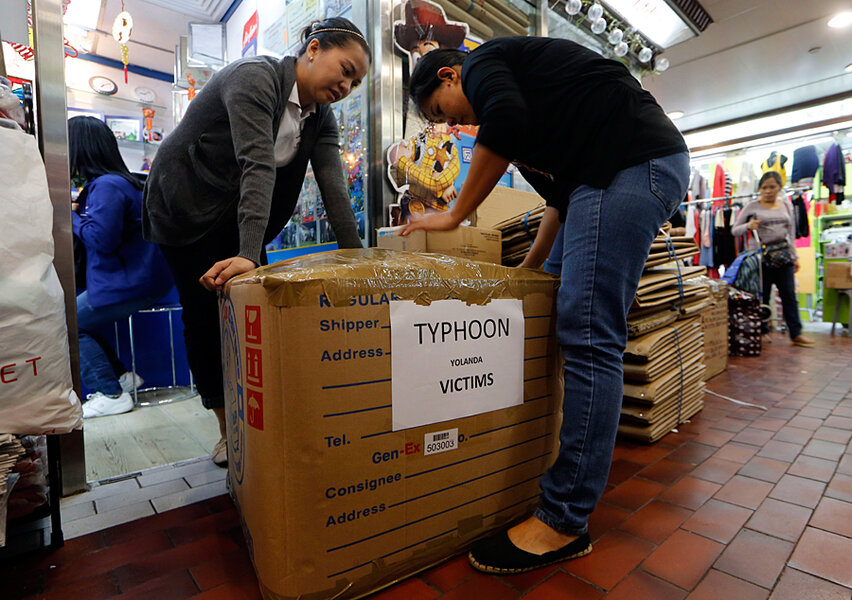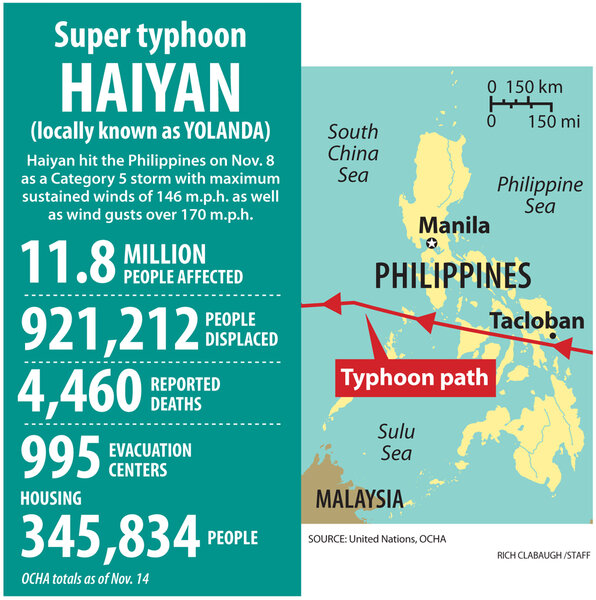Filipinos tap into social media know-how for relief efforts
Loading...
| Eastern Samar, The Philippines
Food, water, and fuel have been slow to reach the coastal towns of this ruggedly beautiful island now littered with palm trees that from the sky look like dandelions crushed under the heels of giants.
In the aftermath of one the worst typhoons ever known to hit land, residents tried to alert the planes that circled above of their needs, gathering debris in the form of splintered wood and scraps of sandy clothing to spell out messages that remain today, like “water please” and “help us.”
As Filipinos do what they can to answer these pleas in the wake of a typhoon that killed at least 3,900 and displaced more than 4 million more, its young and social media-savvy population is rallying to respond to the scenes of devastation. Twenty-somethings from Manila have come together to form small ad hoc aid groups through social media sites such as Facebook. These groups have added appeal for a generation disappointed with their government’s past history of pocketing foreign aid funds from past calamities.
In Guiuan, a town that bore the full force of the storm’s 190-mile-per-hour winds, Lou Razos and a handful of new friends who linked up on Facebook have brought in medical supplies from Manila.
It took 10 days to mobilize 20 people for the aid effort, says Ms. Razos, who also made T-shirts for the new group. The shirts read “Sungkod,” a Filipino word that means a cane or a walking stick, and also an acronym that stands for “synergy of unwavering natives geared towards kin optimism and development,” she says.
These sorts of efforts are helping towns like Guiuan, where 95 percent of the homes “are totally damaged,” says Estelita Apable, an official at the provincial social welfare office. Thanks to groups like Sungkod, “Now we have the medicine,” she says, adding that the town remains in desperate need of fuel.
The social media efforts springing up are in some ways emblematic of the country's population, just over half of whom are under 25. The Philippines ranks among the top 10 countries in terms of the number of Facebook users, according to a July report by the market-research company ComScore.
Beneath the flurry of social media activity lingers distrust of government aid efforts. This week government officials have touted what they promise are new and sincere efforts at transparency. To this end, they are creating a “pioneering web portal” that they have dubbed the Foreign Aid Transparency Hub, or FAiTH, in the hopes that it will speak to a skeptical younger generation.
Still, many remain unconvinced, and are turning to boutique aid operations that are often organized by a friend or a friend of a friend. “You know who is putting together the aid – and you can trust what they say they are doing with the money,” says Gari Buenauista, a Manila resident who says he'd been inspired by the calls to action he's seen through social networking sites.
He and a friend came to the grandstand at Villamor Air Base in Manila, looking for opportunities to volunteer. Normally used for reviewing military parades, these days the grounds more closely resemble a convention center hosting a lively trade show for grass-roots aid projects.
The dense array of booths offer small comforts from home courtesy of volunteer purveyors.
There are stations with stylists offering free haircuts, tech companies offering complementary cellphone recharging hubs, and massage therapists offering neck and shoulder rubs – by far the most popular booth with an incoming flight of evacuees.
Other residents of Manila have shown up with their cars, offering free rides “to bring anyone to anywhere,” says Faith Erasmo.
In the Philippines, it is a phenomenon called bayanihan.
“I’d roughly translate that as ‘town spirit,’ ” says Mr. Buenauista. “It’s when everybody helps to build a house, or transfer a house to another place in a village, then you celebrate afterwards with a shared meal or experience.”
Throughout the country today, as international aid pours in and citizens of Manila mobilize, “it is,” he adds, “a global bayanihan spirit.”








